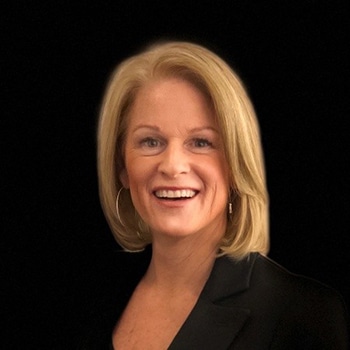Kelvin: We’re going to get started with the Modern Revenue Leader series, and we’re kicking off with Kim Johnson, who is the senior VP of global enterprise sales at Lee Hecht Harrison. It’s the world-leading HR solutions partner. But listen to this: Kim is not just a sales leader; she’s in the game cutting deals. She has, like, this legendary focus on product and service. And she’s kicking off this event because when we got on the call to talk about this event, we were on a call and she was camera-ready.
So, Kim Johnson, you are a modern revenue leader; we are all ears.
Kim: Well, thank you for that introduction, Kell. I hope I live up to the hype. I am so honoured and pleased to be here today to be aside so many talented leaders in the – in multiple industries, right?
Part of what I wanted to get across today in our time together is what does it take to drive performance, especially when everyone is either a hybrid or remote model? How do you do that and how do you get the best out of people in today’s marketplace that is so dynamic, so volatile, right? How do you get the hearts and minds of your sales people? And by, just so you know, not only am I a sales leader, but I am now an individual contributor. So I’ve been a sales leader for 15 years, and decided in the midst of the pandemic – I don’t know what came over me – that I thought I’d better do something different. My heart wasn’t just in leading a team anymore; I felt like I needed to be back in the trenches, refueling myself, re-energizing myself. So I went back into an individual contributor role so I could be closer to the buyer.
And as a result of that I’ve gained a lot of insights. I’ve had a lot of challenges. It’s not for the faint of heart. I can remember so many times I would tell my sales people, hey, it’s just a matter of, you know, putting in the work, doing these sequences, getting those emails out. Well, there’s a lot more to it today. Getting the share, the mind share of a buyer today, takes a lot more effort. It takes a lot more bringing to the table value. And, like you heard Kell mention, it’s being able to leverage connections in a thoughtful way that not just has meaning to you but has meaning to the buyer.
And so what I really want to share with you are four key kind of table stakes that have helped me, not only in driving performance of what I would consider some world-class teams, but also that’s helping me today hit the mark and hopefully exceed the mark.
So the first one is really all about having a growth mind-set. You cannot, in today’s environment, be stuck in the old way of doing things. You have to be constantly open to learning, willing to try new things. Honestly, you have to be fearless and a risk-taker. And as a result of taking those risks and being fearless, you may fall. But by falling and learning from that failure that occurred, you’re going to be better and more effective, more impactful, and really get to the results you’re looking for.
So the first one is all about growth: going out there and trying new things. And then adapting and being agile enough to know when it’s not working, I’m going to tweak it just a little bit and I’m going to try it again.
The second table stake that has been critical to my success, is really [unintelligible 00:03:46] and authentic. And, OK, I’m an African-American woman in a sales leadership role, knocking on doors. You know? I’ve had to overcome a lot of stuff, and some preconceived notions about who I am and what I am capable of. And one of the things I’ve learned is that if I come to the table with me, me being my true whole authentic self, people are drawn to that. They’re connecting to that. They value that. And the more people in selling roles bring their whole self to the table, the more buyers will truly engage and connect with them in a meaningful way, and that’s what it’s really about. It’s about connecting buyers to something that’s important and value to them, but it starts with you. It starts with you making that connection with them.
So that second table stake is all about being authentic and true. And that’s something that I ask my sales people to bring to the table as well. We’re all different, right? We all have unique skills and abilities, and the more that we bring those to the table in our everyday work, the more connection, the more energy, the more value we’re going to have overall.
The third thing for me is laughter. I laugh at myself all the time. Some of the stuff that I say I’m like, did you really just say that? And did you actually get away with it? It’s amazing how much by helping your team laugh and find the humour in certain situations. And even I’ve been in meetings where, you know, it’s the most obvious thing in the room, something doesn’t seem right, and you bring it up in a humorous way, and it just takes all of that kind of anxiousness and funkiness out of the room, and it recalibrates the energy.
So for me laughter is so important. It’s something I do every day, and every moment; there’s always some crazy thing going on when you’re in sales. You know? Just random stuff happens, and the more you can laugh about it and not take all of this so seriously, the more you’re going to enjoy your job, the more your team’s going to enjoy working with you. And what I have found is I have found that my team members would climb a mountain for me, because they know I would do it for them, and we’ve been vulnerable enough together that they have a lot of trust in real commitment towards me, towards the company, and towards our solution.
And my final table stake is something I learned early in my career, and it’s a way that I give feedback that helps the receiver to actually receive it, right? Nobody – when you say I’m going to give you some feedback, the first thing you think is, oh god, what is it? Well, this is a way to give feedback that really disarms the individual and allows them the opportunity to take it in. And it’s called like bests and next times. And so what I do is I’ll say, hey, that call was great. Here are three things I liked best about what you did. And then here are two things that I would recommend that you do next time to even amplify your performance – to level it up one more level. And I have found that that has gone a huge way in helping people really be open to receiving feedback.
And then also, you know, you’re able to do it for yourself, so when I’m not around or they don’t have that opportunity to get feedback directly from me, they start to learn how to give feedback to themselves. Let me assess that conversation I just had with that prospect or that client. You know? What could I have done differently? What are my two next times, and what did I love about what I did? What did I truly like, that I felt like I hit out of the ballpark, and I want to do more of that?
So LBs and NTs is what we call them, and those LBs are things I want to repeat. And the NTs are things I want to replace. I want to do something different next time, and I’ve found people just navigate to that and really accept feedback in a whole different way.
So those are four kind of table stakes for me and what I think have helped me to not only get in the game but play the game really well and be a top performer. And I just want to leave you with one thing that I kind of have in front of my face right now. I have it in front of my face every day, and it’s a quote by Maya Angelou, and it’s: success is liking yourself, liking what you do, and liking how you do it. And I want all of you to be extremely successful, and always think about this, because if it’s not in alignment for you then you need to regroup and think about what you want to do next.
So thank you for your time, and I can’t wait to hear all of the other incredible presenters today.
Take care, everybody.
Note: The following text is transcribed from the event audio. It’s largely accurate, but in some cases it may be a bit off due to inaudible passages or transcription errors. It’s intended as an aid to understanding the event, but it shouldn’t be treated as an authoritative record.






